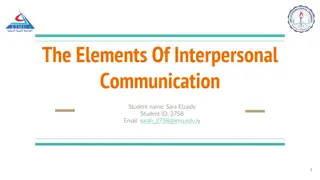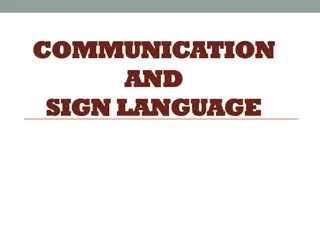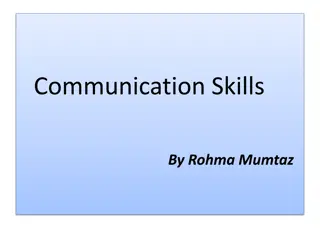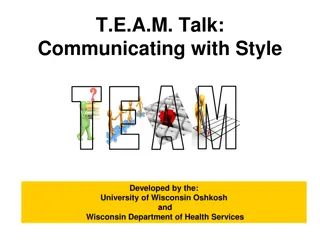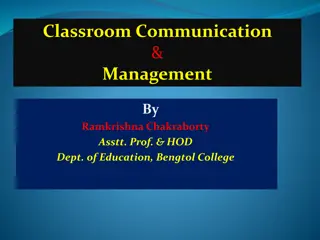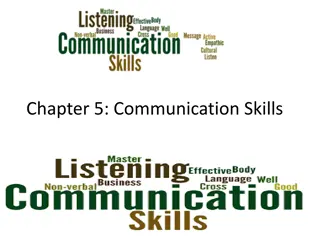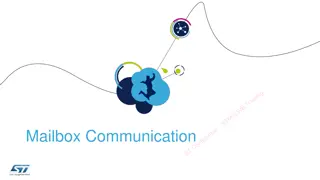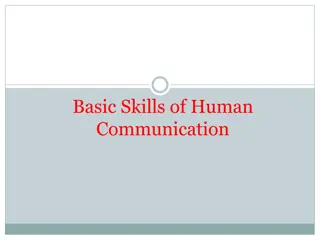Importance of Communication Skills in Understanding Interlocutors
Understanding the significance of communication skills is crucial in establishing connections and adapting to diverse scenarios. Proficient communication involves analyzing non-verbal cues, such as tone, gestures, and eye contact, to effectively relate to others within the initial moments of interaction. Adapting to differences, showcasing adaptability, and expressing oneself authentically are key aspects of effective communication, aiding in making oneself known to the interlocutor.
Download Presentation

Please find below an Image/Link to download the presentation.
The content on the website is provided AS IS for your information and personal use only. It may not be sold, licensed, or shared on other websites without obtaining consent from the author.If you encounter any issues during the download, it is possible that the publisher has removed the file from their server.
You are allowed to download the files provided on this website for personal or commercial use, subject to the condition that they are used lawfully. All files are the property of their respective owners.
The content on the website is provided AS IS for your information and personal use only. It may not be sold, licensed, or shared on other websites without obtaining consent from the author.
E N D
Presentation Transcript
Assoc. Prof. Simona Mina, PhD Constanta Maritime University
Why do we need communication skills? What do you say after you say Good Afternoon? One of the main objectives is to know our interlocutor: we need to relate in order to know our interlocutor within the first 5 minutes of relating. Eric Berne in What do you say after you say Good Afternoon, considers that the process finding out requires an analysis: o Of the first 20 words (through the dynamic elements of expression: volume, tonality, rhythmus) o The first 20 steps (walking is an expressive non-verbal element-we walk in certain enthusiastic and in a different manner when we are under the pressure of the negative emotional stimuli: anxiety, pain). manner when we are stress,
Why do we need communication skills? What do say after we say Good Afternoon? oThe first 20 breaths (the control of breathing is a fundamental non-verbal communication s element in managing stress and anxiety; the success of our tasks, which involve crisis or unforeseen situations, is determined by this control) oThe first 20 looks: (glances and looking are fundamental communication vectors)
Glances and looking, fundamental communication vectors
Why do we need communication skills? What do we do when we notice differences? Another fundamental objective in the communication process is represented by adaptability. The communication skills are measured by a fundamental attribute: the adaptability todifficulties conflicting communication scenarios adaptability to new and diverse situations. The human being is extremely comforted by what exists within the area of anterior experiences and in discomfort towards the new and different situations. What do we do when we notice differences? We try to transform them according to our own habitat and comfort.
Why do we need communication skills? Make ourselves known to the interlocutor The communication skills are necessary in order to make ourselves known to the interlocutor the way we want, and not in a manner that is expected by the interlocutor. o Ever since entering a room, to the manner in which we activate the window of our hidden inner self and do not allow our interlocutors to identify our stress, pain and anxiety resources, or the manner in which we advertise ourselves during a job interview, are all part of thecommunication process.
Why do we need communication skills? Managing conflicts within communication s skills Conflict has existed and it will always exist among people, eitherseparate, or in different groups. Wherever people are, ideas, conjunctures, values, styles, standards will exist, and they might determine conflicts, which means thata conflict might be determined by the following: objectives purposes aspirations unconfirmed expectations habits prejudice competition sensitivity especially aggressiveness the most important of the conflicting presumptions.
Conflict and crisis In S. Deep s and L. Susman sopinion, three causes in perpetuating conflict can be identified: We live in a world that is more complex and diverse, a world in which different people desire different things. Only a few things satisfy everybody, as well as the well-known fact that the human being is apprehensiveof differentor new situations. Working with people means the existence of an ongoing source of conflict Incompatibilities, vanity, egos and egocentrism can only be presumed and/or potentiallyconflicting situation We live and work in a world that imposes certain limits regarding our resources. In this context, the organizational conflicts are determined by the organizational restrictions and to the same extent by the invariably limited resources.
Conflict and crisis The dynamics of the organizations, just like those of the groups, comprise a consensus as well as dialogue and conflict, because, just as R. Hall pointed out, The conflict constitutes an inherent organizational process . Conflict is an important part of the organizational life and the motivations for which the human resources get into a conflict are basically unlimited, from a quantitative point of view. In this context, one of the task s objective of this presentation is to point out a few of the trigger conflict motivations within thework groups, as follows:
Dualism in human relations The existence of dualism in people s relations with their peers: people need to get involved in something, as well as to stand on the side lines, according to their conformation needs, as well as to revolt; furthermore, they need to be part of something noteworthy, as well as being independent from the collectivity. This type of dualism of attitudes is capable of generating intrapersonal, interpersonal and group conflicts
Responsibility of managerial activities The great responsibility of every manager to push the organization from the individual s own influence -, towards performance; the leadership of the whole (organizational objectives and values), by the concentrated force of the divisions, becomes fundamental. Experience has demonstrated organization, usually, the individual interests are paramount in comparison to the general interests. In this context, the human resources will be coordinated, in theiractivity, by personal interests. chaotic tendency the that in any
Responsibility of managerial activities The management s role is to minimize the gap between the individual interest and the organizational interests. Otherwise, the organizational conflict is inherent.
Responsibility of managerial activities
The objectives of the organization and conflicts Regardless of the number of people that agree to the outlined objectives at the organizational level, they will have diverging opinions regarding the manner in which they are carried out; moreover, due to the fundamental characteristic itself of (individuality/difference), the individuals have different opinions. If we include to the aforementioned criteria the fact that people have different values and/or convictions, standards of behavior, manners, priorities, personalities and different levels of the sense of humor, the explanations for the interpersonal and group conflicts are easily identifiable. the human nature
Conflict and crisis Due to the inevitable character of conflicts, the outcome is that managing the human resources is one of the most important activities, and the management of conflict is considered by a specialists in the field, as being just as important as all of the other human resources management s functions. greater number of
Conflict and crisis The study of managing conflicts is more and more taken into consideration by the management of human resources, due contributes to a better understanding of the individual and group organization. Generally, the conflict emerges as a form of human interaction, through which two or more members of a collectivity are in disagreement (totally or partially) with regard to certain problems. to the fact that it behaviors within an
Conflicts and organizational life In an individual opinion, the conflict is generated by the intentional requirement on behalf of an individual and/or a group in an effort to realize the objectives of anothergroup. Given that the objectives of both sides are in many occasions, incompatible, the realization of the object by one of the sides makes its realization by the otherside, impossible.
Conflicts and organizational life: functional or toxic? There are several points of view regarding the role that the conflicts have within the organizational life. On one hand, abnormal dispositions within the activity, having dysfunctional character. conflicts are a profound
Conflicts and organizational life: functional or toxic? On the other hand, conflicts are usual aspects of existence and evolution of business, and from a functional point of view, it has a positive result.
Conflicts and organizational life: functional or toxic? Do you take part of a Paternal Organization? The classics of managerial science present conflict as a bad thing, determined by the lack of understanding among people and the profoundly poor interpersonal relations. The characteristics of the organizational sector, as the main guide of the human behavior, are considered to be guilty for the presence of conflicts. In order to avoid the conflicting coordinates, the organizations will focus on developing a harmonious cooperation between the managementand the employees. The organizations that practice this type of policy promote harmony, the family spirit and helping one another, are considered to be paternal organizations. In their framework, the united team will not accept unwanted interferences that mightdisturb the organization s life.
Conflicts and organizational life: functional or toxic? Another concept, in opposition to the traditional one, called behavior driven, accepts the existence of conflict as an inevitable, and even a desirable fact. concept the presence of conflict is not caused by the organizational sector, instead it is caused by different personal interests, purposesand/orobjectives. It is not beneficial accepting conflict, when the purpose is to follow one s personal interests to fulfill unproductive purposes. However, in the absence of conflicts, apathy might occur, immobility and the organizations inability to adapt to the challenges of change. According to this
Conflicts and organizational life: functional or toxic? In an abstract manner, the management of conflict identifies the causes for conflict and the concrete solutions for a negotiation and it encourages win-win type situations. The situations that can cause stress are discussed and the methods forsolving conflicts are identified. Conflicts are inevitable. In this regard, a recent study carried out by The American Management Association points out that ..The managers spend approximately 20% of their time with conflicts and consider that the ability to negotiate has become very important in the last 10 years .
Causes of conflicts In the management of conflict, the capability to solve conflicting situations is considered to be at the same level and sometimes even more important than planning, communicating, motivating and decision taking. Among the potentially organizational conflict generating sources, are the following: o misunderstandings o inadequate communication o different values o personality dissimilarities, etc. The managers are confronted on adaily basis with internal as well as external conflicts. What causes these conflicts? The researchers have discovered six conflict generating areas, as follows: o managerial authority o the belief and system of values utilized o proposed purposes.
Causes of conflicts In my opinion, aside from the above mentioned causes, we can include as being potentially conflict generating causes within the organizations, the following: The inadequate responsibility of employees The noninvolvement or different participation of the employees in adopting decisions The absenceof the managerial support Rising standardsand the level of performances Rapid technological changes Different managerial styles Organizational environment Age difference Prejudice
Pondys processing model Starts from the premise that the only way to understand a conflict is to identify it as being a dynamic process, rather than stable or static. The latent conflict is determined by the consequences of certain anterior conflicting episodes. Among them, we can mention the following: o the lack of resources o the aspiration for having a lot more autonomy o the differences between the personal objectives and the organization s objectives. The external environment itself, influences the latent conflict
Pondys processing model The comprehended conflict emerges simultaneously with the awareness of existence of certain latent conditions. The divergent objectives and/or the purposes do not determine conflict as long as it is not obvious. Conflict is maintained in a latent state, the ones involved consider it insignificant. It transforms into a perceptible conflict only when we direct ourattention towards it. Therefore, there can be present a great number of conflicts, more than we can manage, and as such, the comprehended conflict does not necessarily have to become a perceptible conflict.
Pondys processing model The manifested conflict it is expressed through behavior, the most frequent reactions being, apathy, dramatic attitude, open aggressiveness. Using the mechanisms managers can anticipate and take measures before the conflictsare manifested openly. There are a few theoretical conflict models. Thomas considers that the conflict models describe either the process, or the structure of a certain conflicting situation. hostility, and/or that they possess, the
Thomass Model in resolving conflicts If a conflict has been resolved, the involved sides can move towards cooperation; if it hasn t been resolved the conflict will increase its intensity, encompassing parts or problems that haven t been, implicated, initially. In order to solve conflicting situations, we can outline as a starting pointa few basiccriteria, in establishing a conflicts pattern: o The essenceof conflicts o The subjects involved in the conflict, the position taken by the actors involved o The degreeof intensity o Shape o Duration o Evolution o The effects generated by theconflicts, respectively.
Asymmetries within the organizations. Is your company decentralized? Special attention must be provided to the asymmetries within the organizations. A flawed developed union life The centralism of the human resources policies are the causes for asymmetrical, power struggle conflicts, which unfortunately the employer-employee rapport will end in a win lose situation with the triumph of the employees, they are part of a special status group.
Asymmetries within the organizations. Is your company decentralized? The position taken by the actors involved in the conflict allows the symmetrical and asymmetrical differentiation of conflicts. In this context, the conflicts frequently arise among the sides that have a different predominance, such as the majority and the minority, a legitimate government and a rebel group, an owner and itsemployees, etc. These types of conflicts are asymmetrical, and their genesis is not found in the typical problems or aspects that might divide the sides, it is found in the structure that constitutes the sides. It seems that no structure given by the role and/or relations cannot be changed, without the emergence of a conflict.
Asymmetries within the organizations. Is your company decentralized? In the asymmetrical conflicts the structure is constituted in such a manner, that the big fish always gulps the smaller fish . The only solution is to change the structure; however this is not always in the interest of the big fish . As such, there are no win-win results, and the third party can only join forces with the smaller fish , in order to reach a solution. If this doesn t take place, the big fishes will try to maintain their power and keep under control the smaller fishes .
Asymmetries within the organizations. Is your company decentralized? Depending on the degree of intensity, the conflicting states can be manifested through discomfort, incidents, misunderstanding, tensions and crisis. The discomfort is the intuitive feeling that things are not normal, even though theconflicting statecannot be precisely defined. The incident is a nuisance over time and is the basis of more intense conflicts, and that is why they are not forgotten. An incident can be just a simple problem, but when it is misunderstood, it can escalate in tension. Misunderstanding is a form of conflict caused by erroneous perceptions, by the lack of connection among the sides and/or inadequatecommunication. Finally, tension and crisis are two extreme forms of conflict people gooverboard and let themselves bedominated by feeling.




